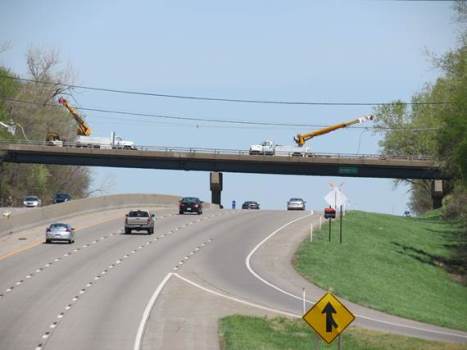
On Monday, May 5, a replacement project will begin on the Gibbs Road Bridge over I-635 in Wyandotte County.
Project work includes the replacement of the existing 40-foot steel girder structure (built in 1971) with a new 40-foot steel girder structure complete with sidewalk. Work will take place during daylight hours, Monday through Friday, with some occasional overnight and weekend work.
Beginning on Monday, May 5, after morning rush hour, eastbound and westbound Gibbs Road from 42nd Street to 47th Street will be closed to all through traffic, round the clock, throughout the project duration. A marked detour will be provided. Traffic will detour via 42nd and 47th Streets to Shawnee Drive.
Demolition of the existing Gibbs Road Bridge will begin on Monday, May 5, as well. The exact demolition plans have not been finalized as of yet. When the bridge is demolished there may be full roadway closures on I-635. A marked detour route will be provided. Traffic will detour via K-32 to 18th Street Expressway to I-35. Advance separate notification will be issued when the full schedule for bridge demotion work is completed.
Northbound shoulder and southbound I-635 left lane will be closed for eight consecutive weeks for bridge pier construction work. Northbound I-635 will be restricted at this time to three 11-foot wide lanes. The posted speed limit will be reduced to 55 mph through the project work zone during this eight-week closure. Advance separate notification will be issued when the start date has been scheduled for this portion of work.
Advance message boards will alert traffic to roadway closures on both Gibbs Road and I-635. Traffic will be directed via signs and cones through the project work zone. Drivers should expect delays and allow extra time during peak commute times on I-635.
Updated daily traffic information for this project and for the entire Kansas City metro area can be viewed online any time at: www.ksdot.org/kcmetro/laneclose.asp.
The Kansas Department of Transportation urges all motorists to be alert, obey the warning signs, and slow down when approaching and driving through the project work zone.
Phillips Hardy, Columbia, Mo., is the primary contractor on bridge replacement project with a total contract cost of $2.38 million. The scheduled completion date for the entire project is early September 2014, weather permitting.
This project is funded by T-WORKS, the transportation program passed by the Kansas Legislature in May 2010. Find out more about this and other T-WORKS projects at: http://kdotapp.ksdot.org/TWorks/.
